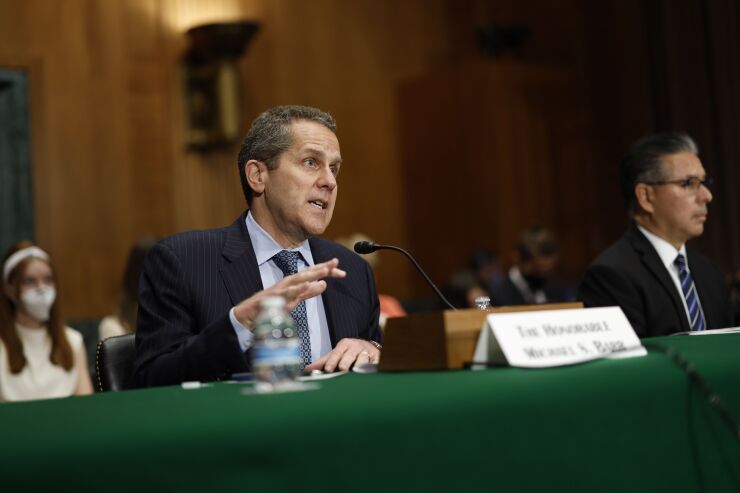
NEW YORK — The Federal Reserve's top regulator says
In a speech Monday afternoon, Fed Vice Chair for Supervision Michael Barr said the discount window — through which banks can secure loans on-demand liquidity by posting high quality assets as collateral — is a critical tool for protecting financial stability. But, he noted, too often banks wait to familiarize themselves with the facility until it is
"When the system is hit with a shock that results in widespread stress, funding markets are often unable to effectively distribute liquidity," Barr said. "In these cases, the discount window can be particularly important both to the institutions that need liquidity and to the Federal Reserve's efforts to stop dysfunction from spreading and restore stability, but, again, only if banks do the work ahead of time and are ready and able to use it."
Barr's remarks, delivered at a luncheon hosted by the Forecasters Club of New York, echo comments made by
The Fed also joined other bank regulators in issuing
Barr's comments on emergency borrowing came at the tail end of a speech on the
During the speech, Barr said it is critical that monetary policymakers be "cognizant" of the impacts their actions have on financial stability, noting that failing to do so could hamper the Fed's ability to deliver its two mandates: stable prices and full employment.
"Monetary policy cannot be indifferent to financial stability risks," Barr said. "When financial stability events materialize, they can significantly affect both the price and quantity of credit to the economy. At that point, financial stability problems become a monetary policy concern, as they can adversely affect the flow of credit to households and businesses as well as depress economic activity."
At the same time, he said, he favors dealing with risk management and monetary concerns with different tools. Specifically, he noted the importance of supervision in both mitigating risks within the banking system and informing monetary policymakers on the impacts of their actions.
"As the first line of defense, where we have authority, supervision and regulation are best positioned to address vulnerabilities in the financial system as they emerge," Barr said.
After delivering his prepared remarks, Barr responded to a wide range of questions from the event's attendees, covering topics such as the impact of the Fed's recently
Capital
Barr said he does not expect the
"One of the great strengths of the U.S. banking system is the diversity of business models," Barr said. " We want to make sure that regulation encourages that continued diversification of the financial system."
He also pushed back against the idea that because the new regulations would result in U.S. banks
"U.S. banks have been operating at high levels of capital, really since the after the global financial crisis, and though it depends a little bit how you measure it, probably higher capital levels than their European counterparts, and U.S. institutions that have done extraordinarily while their European institutions have done less well," he said. "I don't think there's a direct relationship between how much capital institutions hold and their international competitiveness. In fact, if there is a relationship it's likely the reverse, that holding higher levels of capital makes them competitive. That's what the experience has been."
Balance sheet
Barr said the Fed's
As the level of reserves at the central bank do fall, Barr said Fed officials will watch closely to ensure there are still enough in the system to allow for the smooth functioning of bank activity.
"We're very attentive to what the right level of reserves in the system is," he said. "That's something that we're going to feel our way towards. We're not anywhere close to that lower bound level, but we will be attentive to the financial stability frame for thinking about what the right level of demand is in the system and the level of reserves we need to have."
Credit conditions
On the state of credit availability in the banking system, Barr said lending
"The amount of credit tightening we're seeing is less than I feared in March. That is, I was concerned, very much concerned in March that we would see an abrupt change in credit conditions, and we're not seeing that abrupt change," he said. "We're seeing a gradual change in credit. Bank stress as lags the way monetary policy lags, so it's possible that some of that stress is still to be seen in further credit tightening in the future. But we seem to have avoided massive instant contraction in credit that could have been the result."
Housing
Barr acknowledged the complicated relationship between housing prices and interest rates. On one hand, the cost of housing services — an index measure that largely focuses on rents and rental equivalent price estimates from homeowners — are poised to fall significantly in the coming months. He said the Fed is seeing the "right kind of slowing" in the sector.
At the same time, he said, home prices have not come down as a result of higher interest rates. Instead, they have risen, partially because existing owners are
"We do see that house prices are not as heavily influenced by rates and the historical experience suggested that has happened before, too, so house prices … don't function as smoothly in relation to interest rates as you might expect," he said. "But the endpoint is happening, which is that we see and expect to continue to see housing services inflation [fall]."
AI
As for
"I do think that the potential positive and negative implications for generative AI could be quite large," Barr said. "I don't think there's an overall answer to 'Good or bad?' It's coming and we have choices to make about how to relate to it as private citizens and, in the official sector, to make sure we capture as much of the upside as we can and have guardrails against as much of the downside as we can."






